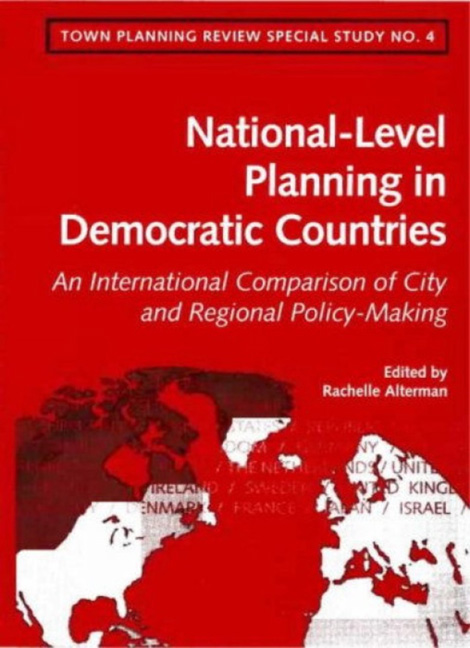 National-Level Spatial Planning in Democratic Countries
National-Level Spatial Planning in Democratic Countries Book contents
- Frontmatter
- Dedication
- Contents
- List of Figures
- List of Tables
- Preface
- About the Contributors
- 1 National-Level Planning in Democratic Countries: A Comparative Perspective
- 2 National Land-Use Planning and Regulation in the United States: Understanding its Fundamental Importance
- 3 Structures for Policy-Making and the Implementation of Planning in the Republic of Ireland
- 4 Rethinking Swedish National Planning
- 5 National-Level Institutions and Decision-Making Processes for Spatial Planning in the United Kingdom
- 6 National-Level Planning Institutions and Decisions in the Federal Republic of Germany
- 7 National-Level Planning in the Danish System
- 8 National-Level Planning Institutions and Decision-Making in France
- 9 National-Level Economic and Spatial Planning in Japan
- 10 Dutch National Planning at the Turning Point: Rethinking Institutional Arrangements
- 11 National-Level Planning in Israel: Walking the Tightrope Between Government Control and Privatisation
7 - National-Level Planning in the Danish System
- Frontmatter
- Dedication
- Contents
- List of Figures
- List of Tables
- Preface
- About the Contributors
- 1 National-Level Planning in Democratic Countries: A Comparative Perspective
- 2 National Land-Use Planning and Regulation in the United States: Understanding its Fundamental Importance
- 3 Structures for Policy-Making and the Implementation of Planning in the Republic of Ireland
- 4 Rethinking Swedish National Planning
- 5 National-Level Institutions and Decision-Making Processes for Spatial Planning in the United Kingdom
- 6 National-Level Planning Institutions and Decisions in the Federal Republic of Germany
- 7 National-Level Planning in the Danish System
- 8 National-Level Planning Institutions and Decision-Making in France
- 9 National-Level Economic and Spatial Planning in Japan
- 10 Dutch National Planning at the Turning Point: Rethinking Institutional Arrangements
- 11 National-Level Planning in Israel: Walking the Tightrope Between Government Control and Privatisation
Summary
A little Danish planning history
Denmark covers a land area of 43 000 square kilometres, not including the self-governing regions of Greenland and the Faroe Islands. The country's population is 5.2 million, of which one-third lives in the capital region—Greater Copenhagen. Sixty-seven per cent of the country is devoted to agriculture, 12 per cent to forests, 11 per cent to semi-natural areas and 10 per cent to urban zones and transport installations.
The first Danish town planning act was passed in 1925. It was, however, not widely applied because the planning regulations entailed an economic risk since the municipal councils were held responsible for paying compensation. In 1938 a new planning act was passed which obligated the municipal councils to adopt a town plan for any built-up area with more than 1000 inhabitants. The town plan was subject to the approval of the Minister of Housing. A considerable number of town plans were then adopted, as the planning regulations did not require the municipal councils to pay compensation to landowners. The plan, however, only related to towns and there was no legal basis for ensuring the separation of urban and rural areas or for limiting urban growth. The resulting urban sprawl created the need for a bill, passed in 1949, which set up urban development committees for all expanding urban districts. The committees provided urban development plans, which divided the expanding areas into zones and preserved areas of open country. This forms the basis for the present zoning division of the whole country.
As in many other countries, urban development in Denmark accelerated between 1945 and the mid-1980s. The resulting new urban districts, which include residential and commercial areas and centre and service functions, now encompass 75 per cent of the developed urban land and half of the population. This huge urban development was regulated mainly by the zoning provisions, and by the urban development committees. The municipalities developed master plans for the cities and towns, and district and regional plans were voluntarily prepared in several areas.
These master plans indicated the need for overall comprehensive planning and led to the planning law reform of the mid-1960s. This was based on the local government reform which came into force in 1970 and reduced the number of counties from 25 to 14 and the number of local authorities from 1388 municipalities to 275.
- Type
- Chapter
- Information
- National-Level Spatial Planning in Democratic CountriesAn International Comparison of City and Regional Policy-Making, pp. 148 - 167Publisher: Liverpool University PressPrint publication year: 2001


